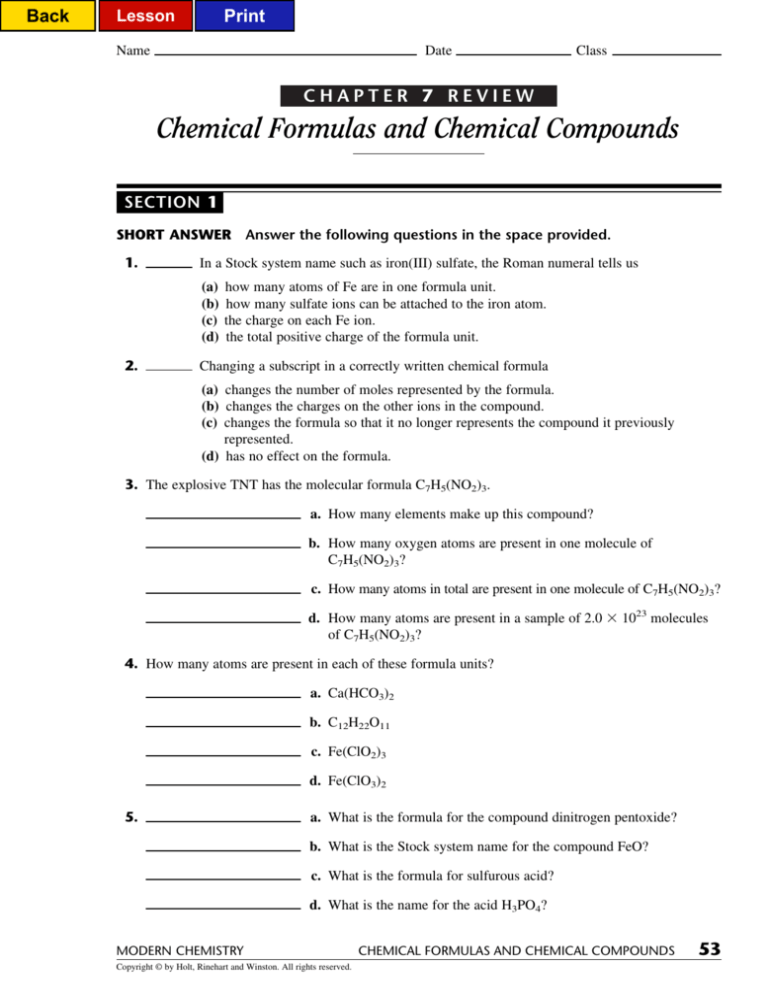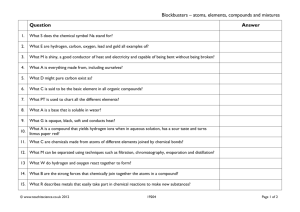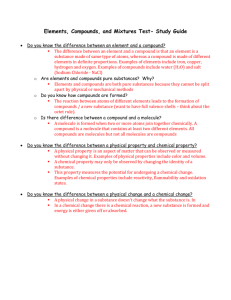
Back
Print
Lesson
Name
Date
Class
CHAPTER 7 REVIEW
Chemical Formulas and Chemical Compounds
SECTION 1
SHORT ANSWER
1.
In a Stock system name such as iron(III) sulfate, the Roman numeral tells us
(a)
(b)
(c)
(d)
2.
Answer the following questions in the space provided.
how many atoms of Fe are in one formula unit.
how many sulfate ions can be attached to the iron atom.
the charge on each Fe ion.
the total positive charge of the formula unit.
Changing a subscript in a correctly written chemical formula
(a) changes the number of moles represented by the formula.
(b) changes the charges on the other ions in the compound.
(c) changes the formula so that it no longer represents the compound it previously
represented.
(d) has no effect on the formula.
3. The explosive TNT has the molecular formula C7H5(NO2)3.
a. How many elements make up this compound?
b. How many oxygen atoms are present in one molecule of
C7H5(NO2)3?
c. How many atoms in total are present in one molecule of C7H5(NO2)3?
d. How many atoms are present in a sample of 2.0 1023 molecules
of C7H5(NO2)3?
4. How many atoms are present in each of these formula units?
a. Ca(HCO3)2
b. C12H22O11
c. Fe(ClO2)3
d. Fe(ClO3)2
5.
a. What is the formula for the compound dinitrogen pentoxide?
b. What is the Stock system name for the compound FeO?
c. What is the formula for sulfurous acid?
d. What is the name for the acid H3PO4?
MODERN CHEMISTRY
Copyright © by Holt, Rinehart and Winston. All rights reserved.
CHEMICAL FORMULAS AND CHEMICAL COMPOUNDS
53
Back
Lesson
Print
Name
Date
Class
SECTION 1 continued
6. Some binary compounds are ionic, others are covalent. The type of bond favored partially depends
on the position of the elements in the periodic table. Label each of these claims as True or False; if
False, specify the nature of the error.
a. Covalently bonded binary molecular compounds are typically composed of nonmetals.
b. Binary ionic compounds are composed of metals and nonmetals, typically from opposite sides of
the periodic table.
7. Refer to Table 2 on page 226 of the text and Table 5 on page 230 of the text for examples of
names and formulas for polyatomic ions and acids.
a. Derive a generalization for determining whether an acid name will end in the suffix -ic or -ous.
b. Derive a generalization for determining whether an acid name will begin with the prefix hydroor not.
8. Fill in the blanks in the table below.
Compound name
Formula
Aluminum sulfide
Cesium carbonate
PbCl2
(NH4)3PO4
Hydroiodic acid
54
CHEMICAL FORMULAS AND CHEMICAL COMPOUNDS
MODERN CHEMISTRY
Copyright © by Holt, Rinehart and Winston. All rights reserved.
Back
Print
Lesson
Name
Date
Class
CHAPTER 7 REVIEW
Chemical Formulas and Chemical Compounds
SECTION 1
SHORT ANSWER
1.
c
In a Stock system name such as iron(III) sulfate, the Roman numeral tells us
(a)
(b)
(c)
(d)
2.
c
Answer the following questions in the space provided.
how many atoms of Fe are in one formula unit.
how many sulfate ions can be attached to the iron atom.
the charge on each Fe ion.
the total positive charge of the formula unit.
Changing a subscript in a correctly written chemical formula
(a) changes the number of moles represented by the formula.
(b) changes the charges on the other ions in the compound.
(c) changes the formula so that it no longer represents the compound it previously
represented.
(d) has no effect on the formula.
3. The explosive TNT has the molecular formula C7H5(NO2)3.
4 elements
6 oxygen atoms
21 atoms
4.2 1024 atoms
a. How many elements make up this compound?
b. How many oxygen atoms are present in one molecule of
C7H5(NO2)3?
c. How many atoms in total are present in one molecule of C7H5(NO2)3?
d. How many atoms are present in a sample of 2.0 1023 molecules
of C7H5(NO2)3?
4. How many atoms are present in each of these formula units?
5.
11 atoms
a. Ca(HCO3)2
45 atoms
b. C12H22O11
10 atoms
c. Fe(ClO2)3
9 atoms
d. Fe(ClO3)2
N2O5
iron(II) oxide
a. What is the formula for the compound dinitrogen pentoxide?
b. What is the Stock system name for the compound FeO?
H2SO3
c. What is the formula for sulfurous acid?
phosphoric acid
d. What is the name for the acid H3PO4?
MODERN CHEMISTRY
Copyright © by Holt, Rinehart and Winston. All rights reserved.
CHEMICAL FORMULAS AND CHEMICAL COMPOUNDS
53
Back
Lesson
Print
Name
Date
Class
SECTION 1 continued
6. Some binary compounds are ionic, others are covalent. The type of bond favored partially depends
on the position of the elements in the periodic table. Label each of these claims as True or False; if
False, specify the nature of the error.
a. Covalently bonded binary molecular compounds are typically composed of nonmetals.
True
b. Binary ionic compounds are composed of metals and nonmetals, typically from opposite sides of
the periodic table.
True
7. Refer to Table 2 on page 226 of the text and Table 5 on page 230 of the text for examples of
names and formulas for polyatomic ions and acids.
a. Derive a generalization for determining whether an acid name will end in the suffix -ic or -ous.
In general, if the anion name ends in -ate, the corresponding acid name will end in a
suffix of -ic. In general, if the anion name ends in -ite, the corresponding acid name
will end in a suffix of -ous.
b. Derive a generalization for determining whether an acid name will begin with the prefix hydroor not.
In general, if the anion name ends in -ide, the corresponding acid name will end in a
suffix of -ic and begin with a prefix of hydro-. The prefix hydro- is never used for
anions ending in -ate or -ite.
8. Fill in the blanks in the table below.
54
Compound name
Formula
Aluminum sulfide
Al2S3
Cesium carbonate
Cs2CO3
Lead(II) chloride
PbCl2
Ammonium phosphate
(NH4)3PO4
Hydroiodic acid
HI
CHEMICAL FORMULAS AND CHEMICAL COMPOUNDS
MODERN CHEMISTRY
Copyright © by Holt, Rinehart and Winston. All rights reserved.









